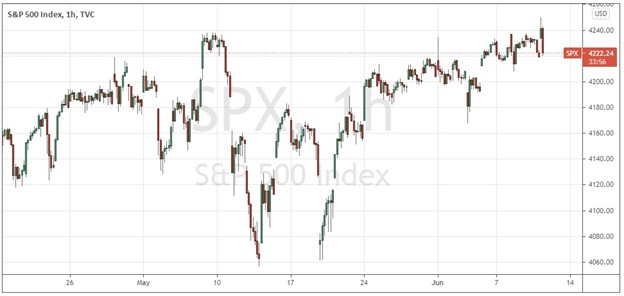June 2021 Inflation Data
The U.S. CPI for May 2021 was reported as increasing month on month by 0.6%, higher than the consensus forecast of 0.4%. This represents a year-on-year increase of 5.0%. Core CPI, arguably a more reliable inflation indicator, was reported as increasing month on month by 0.7%, higher than the consensus forecast of 0.4%. This represents a year-on-year increase of 3.8%. These are the highest U.S. inflation numbers seen in 28 years.
At this early stage, analysts are split on the seriousness of the inflation data. Some economists point to the fact that most of the increase in the CPI is accounted for by higher pricing in sectors which were hit hardest by the impact of the novel coronavirus in 2020, which presumably would be more of a reactionary than a “true” inflation. However, other analysts will say a price hike is a price hike and that it is all the same inflationary pressure. Those same analysts will also tend to agree that it is significant we are also seeing a smaller but real pickup in inflation across a wider segment of the economy than airlines, hospitality, and other notable corona victims.
June 2021 Inflation: Market Impact
The broad benchmark U.S. equity index, the S&P 500, initially rose by a small but technically significant amount, trading at new all-time high prices to reach as much as only a fraction below the big number at 4250. Two and a half hours after the data release, the price has failed to hold up above today’s open or yesterday’s high price, which may be a bearish sign.

S&P 500 Index Hourly Chart April-June 2021
The U.S. Dollar Index moved lower following the release, which may be a sign that the market is tending more towards concern than relative unconcern over the inflation data. Expectation of a faster rate rise would normally be expected to boost, not reduce, the greenback.
The biggest gainers against the U.S. Dollar among major currencies were the New Zealand and Australian Dollars, perhaps due to a global picture of commodity price inflation, while the Euro barely advanced against the U.S. Dollar at all. The Euro may have been impacted by the monthly ECB policy statement today although the market seemed to take that very smoothly, as it caused no real surprise.
Major commodities remained largely unchanged.
What Does This Mean for Traders?
Two hours after the release of surprisingly high U.S. inflation data, the longer-term market impact seems unclear. If the S&P 500 Index closes above the all-time high at 4250, that might become an interest bullish breakout to be traded long. Generally, it seems wisest to sit on the sidelines and wait to see how the rest of the day plays out.
